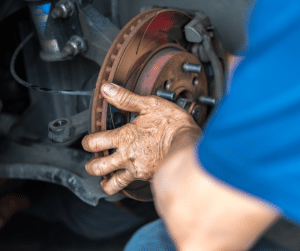Your car’s brakes are its most important safety feature — and they wear out over time. Ignoring brake issues can put you and others at serious risk, especially in an emergency. So how do you know when it’s time for a brake check?
How Often Should Brakes Be Checked?
You should have your brakes inspected at least once a year, or every 10,000–15,000 km, depending on how and where you drive. City drivers who stop frequently will wear brakes faster than highway cruisers.

Common Signs Your Brakes Need Attention
- Squealing or grinding noises: High-pitched squeals can mean worn brake pads. Grinding suggests metal-on-metal contact — a sign of serious wear.
- Vibrating brake pedal: This could be due to warped brake rotors, often caused by excessive heat or wear.
- Soft or spongy pedal: If the brake pedal feels soft or sinks to the floor, it may indicate air in the brake lines or fluid issues.
- Longer stopping distances: If your car isn’t stopping like it used to, something’s wrong get it checked immediately.
- Pulling to one side: Uneven braking can be a sign of sticking callipers or worn brake pads.
Why It Matters
Worn brakes can lead to:
- Increased stopping distance
- Brake failure
- Expensive repairs if left too long

Brake maintenance isn’t something to delay. A quick check now could prevent an accident later. Book a brake inspection at Express Lube our Central Coast mechanics can assess pads, rotors, fluid, and everything in between to keep you safe and in control on the road.






